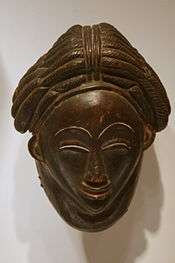Punu-Lumbo mask
A Punu-Lumbo mask is a tribal mask native to the Ogooué River basin in Gabon, especially in the south in Ngounié Province.[1] The masks are extremely valuable to collectors of African art, and have been sold at Sotheby's for well over $400,000.[2] The earliest known example, collected in 1867, is part of the Pitt Rivers Museum collection at the University of Oxford.[3] Several other museums, such as the National Museum of African Art in Washington, D.C. are in possession of one. They have been featured in the African Negro Art show at the Museum of Modern Art in New York City (1935),[4] and at the Museum voor Volkenkunde, in Rotterdam (1953).[5] The masks were popular among European collectors during the 1920s and 1930s.[6]

Design
Compared stylistically to Japanese art,[7] the masks are typically oval in shape, with narrowed eyes, arched eyebrows and small ears.[2] The male masks (ikwar) tend to be brown and black pigment over kaolin and viewed as ugly and are shown at night whilst the masks for females (mukudj) tend to be lighter and considered prettier by the locals and are shown in the day.[8] The Okuyi (or mokuyi) white-faced masks commonly contain nine scale-like patterns on the forehead. This is said to be a "central eye" and also a flowering tree.[9] The white color, usually derived from kaolin,[10] represents clarity, light, and beauty.[11]
Use
Male dancers are known to wear the Okuyi while dancing.[12] The white-faced masks are also used by other Gabon and Zaire rainforest people, such as the Kotas and Mpongwe,[13] The Ashira also share in the white-faced mask tradition, which includes soft facial characteristics.[14] The masks have been linked to the Mukui society and to female ancestor celebration dances,[7] a funerary spirit association.[15] A variation of the Punu-Lumbo mask is produced by the Tsangui in the northern Democratic Republic of the Congo.[16]
References
- Musée Barbier-Mueller. Association des amis (2005). Arts and Cultures. The Association of Friends of the Barbier-Mueller Museum. p. 190. ISBN 978-88-7439-229-2. Retrieved 31 March 2012.
- "A Magnificent Punu-Lumbo Mask, Gabon". Sotheby's. Retrieved 31 March 2012.
- Teuten, Timothy (28 April 1995). The collector's guide to masks. Bracken. p. 32. ISBN 978-1-85891-201-1. Retrieved 31 March 2012.
- Tribal: the magazine of tribal art. Primedia, Inc. 2007. p. 30. Retrieved 31 March 2012.
- Museum voor Volkenkunde; Greub, Suzanne; Houston, Museum of Fine Arts (1988). Expressions of belief: masterpieces of African, Oceanic, and Indonesian art from the Museum voor Volkenkunde, Rotterdam. Rotterdam, Netherlands: Rizzoli. p. 36. ISBN 978-0-8478-0959-2. Retrieved 31 March 2012.
- University of Pennsylvania. University Museum; Wardwell, Allen (1986). African sculpture from The University Museum, University of Pennsylvania. Philadelphia Museum of Art. p. 88. ISBN 978-0-8122-7956-6. Retrieved 31 March 2012.
- "Punu Information". University of Iowa. November 3, 1998. Archived from the original on 8 April 2012. Retrieved 31 March 2012.
- JSTOR (Organization) (1 January 2001). African Arts. African Studies Center, University of California, Los Angeles. p. 22. Retrieved 31 March 2012.
- Dunne, Claire (4 July 2002). Carl Jung: Wounded Healer of the Soul: An Illustrated Biography. Continuum International Publishing Group. pp. 12–. ISBN 978-0-8264-6307-4. Retrieved 31 March 2012.
- African Studies Center (1 January 2001). African arts. Volume 34, Issues 1–4. JSTOR. University of California, Los Angeles. p. 22. Retrieved 31 March 2012.
- Werness, Hope B. (20 March 2003). The Continuum Encyclopedia of Native Art: Worldview, Symbolism, and Culture in Africa, Oceania, and North America. Continuum International Publishing Group. p. 232. ISBN 978-0-8264-1465-6. Retrieved 31 March 2012.
- Sathisan, Dinesh (March–April 2011). "The Ideal Beauty of the Punu Okuyi". Passage: 17.
- Hollingsworth, Mary (2004). Art in World History. Giunti Editore. p. 123. ISBN 978-88-09-03474-7. Retrieved 31 March 2012.
- Perani, Judith; Smith, Fred T. (1998). The visual arts of Africa: gender, power, and life cycle rituals. Prentice Hall. p. 217. ISBN 978-0-13-442328-9. Retrieved 31 March 2012.
- "Exhibition: Beyond the Eye of the Beholder: Ideals of Human Beauty in Africa and the Americas". Jerusalem: The Israel Museum. Retrieved 31 March 2012.
- Muzeʼon Yiśraʼel; Newton, Douglas (2001). African and Oceanic art in Jerusalem: the Israel Museum collection. Jerusalem: Israel Museum. Retrieved 31 March 2012.